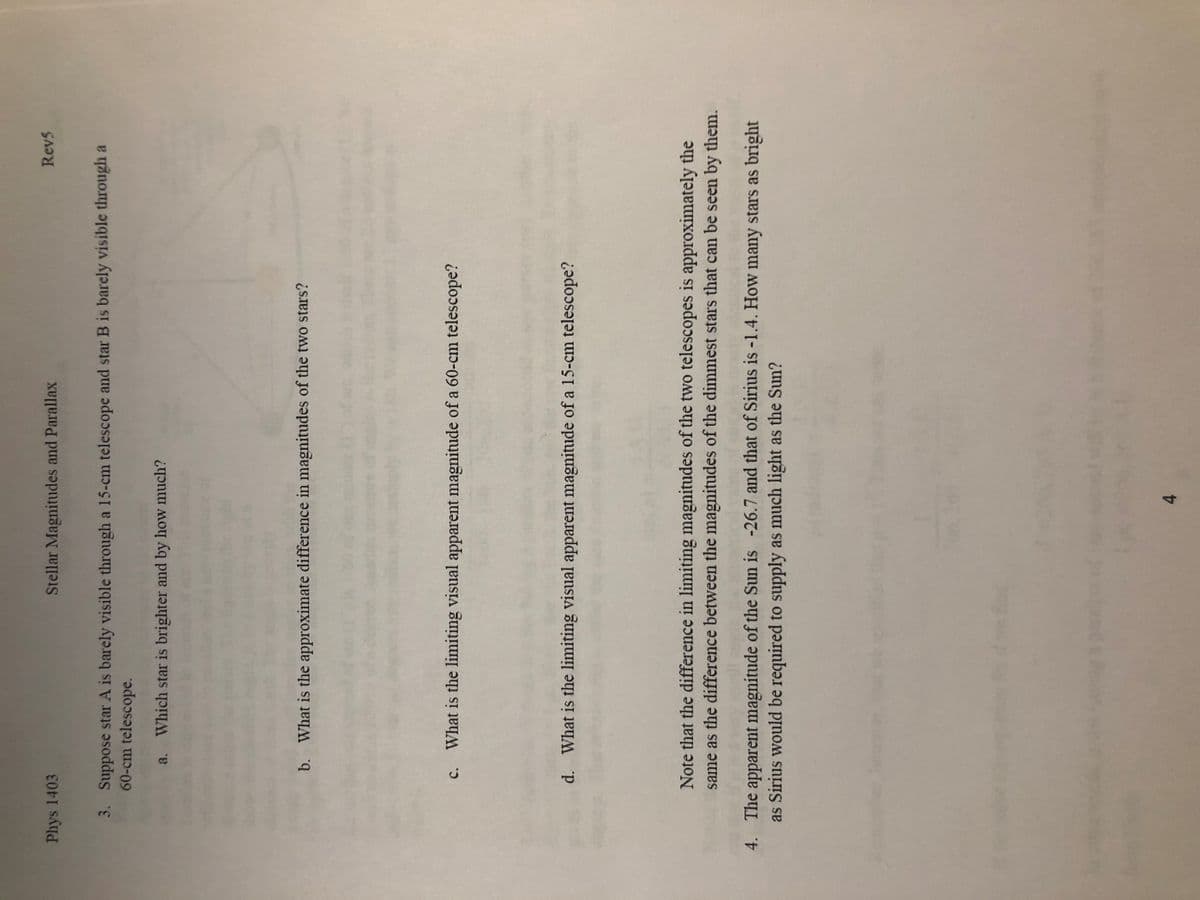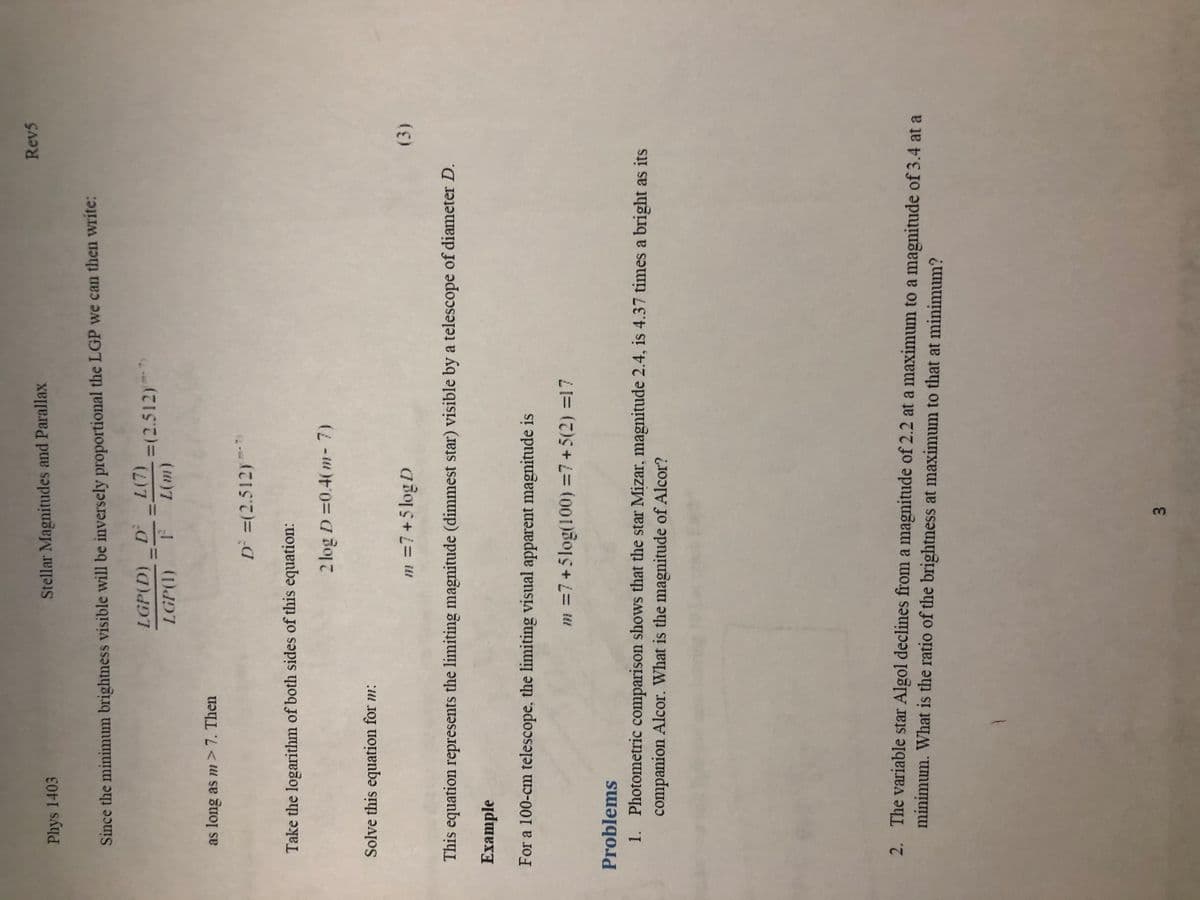Rev5 Phys 1403 Stellar Magnitudes and Parallax Since the minimum brightness visible will be inversely proportional the LGP we can then write: =(2.512) %3D %3D LGP(1) ()7 as long as m>7. Then D =(2.512)" Take the logarithm of both sides of this equation: 2 log D =0.4(m -7) Solve this equation for m: m =7+5 log D (3) This equation represents the limiting magnitude (dimmest star) visible by a telescope of diameter D. Example For a 100-cm telescope, the limiting visual apparent magnitude is m =7+5log(100) =7+5(2) =17 Problems 1. Photometric comparison shows that the star Mizar, magnitude 2.4, is 4.37 times a bright as its companion Alcor. What is the magnitude of Alcor? 2. The variable star Algol declines from a magnitude of 2.2 at a maximum to a magnitude of 3.4 at a minimum. What is the ratio of the brightness at maximum to that at minimum?
Rev5 Phys 1403 Stellar Magnitudes and Parallax Since the minimum brightness visible will be inversely proportional the LGP we can then write: =(2.512) %3D %3D LGP(1) ()7 as long as m>7. Then D =(2.512)" Take the logarithm of both sides of this equation: 2 log D =0.4(m -7) Solve this equation for m: m =7+5 log D (3) This equation represents the limiting magnitude (dimmest star) visible by a telescope of diameter D. Example For a 100-cm telescope, the limiting visual apparent magnitude is m =7+5log(100) =7+5(2) =17 Problems 1. Photometric comparison shows that the star Mizar, magnitude 2.4, is 4.37 times a bright as its companion Alcor. What is the magnitude of Alcor? 2. The variable star Algol declines from a magnitude of 2.2 at a maximum to a magnitude of 3.4 at a minimum. What is the ratio of the brightness at maximum to that at minimum?
Related questions
Question

Transcribed Image Text:Phys 1403
Stellar Magnitudes and Parallax
Rev5
3. Suppose star A is barely visible through a 15-cm telescope and star B is barely visible through a
60-cm telescope.
a.
Which star is brighter and by how much?
b. What is the approximate difference in magnitudes of the two stars?
c. What is the limiting visual apparent magnitude of a 60-cm telescope?
d. What is the limiting visual apparent magnitude of a 15-cm telescope?
Note that the difference in limiting magnitudes of the two telescopes is approximately the
same as the difference between the magnitudes of the dimmest stars that can be seen by them.
4. The apparent magnitude of the Sun is -26.7 and that of Sirius is -1.4. How many stars as bright
as Sirius would be required to supply as much light as the Sun?
4.

Transcribed Image Text:3.
Rev5
Phys 1403
Stellar Magnitudes and Parallax
Since the minimum brightness visible will be inversely proportional the LGP we can then write:
LGP(D) D L(7) -(2.512)
LGP(1)
(m)7
as long as m> 7. Then
D =(2.512)*
Take the logarithm of both sides of this equation:
2 log D 0.4( m- 7)
Solve this equation for m:
m =7+5 log D
(3)
This equation represents the limiting magnitude (dimmest star) visible by a telescope of diameter D.
Example
For a 100-cm telescope, the limiting visual apparent magnitude is
m =7+5log(100) =7+5(2) =17
Problems
1. Photometric comparison shows that the star Mizar, magnitude 2.4, is 4.37 times a bright as its
companion Alcor. What is the magnitude of Alcor?
2. The variable star Algol declines from a magnitude of 2.2 at a maximum to a magnitude of 3.4 at a
minimum. What is the ratio of the brightness at maximum to that at minimum?
Expert Solution
This question has been solved!
Explore an expertly crafted, step-by-step solution for a thorough understanding of key concepts.
This is a popular solution!
Trending now
This is a popular solution!
Step by step
Solved in 3 steps
